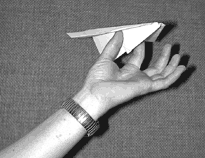|
||||||||
|
|
||||
|
The forces of the wind on the airplane can also be treated as one force acting through a point called the "center of lift." Get a large fan. Hold the body of the plane loosely between two fingers with the nose of the plane pointing toward the floor. Then move the plane into the blast of air from the fan. There is only one place that you can hold the plane so that it will balance against the wind. Move your fingers along the body of the plane until you find the point at which the plane remains exactly vertical. Mark this point, which is the center of lift. No matter how thick the airplane is, the air only pushes on the bottom layer, so the shape of the plane controls the center of lift. So we have gravity pulling down at the center of gravity, and air pushing up at the center of lift. In a properly designed glider, the center of gravity is in front of the center of lift so that the nose of the glider drops. (Check your pencil marks to find out if this is the case for your plane.) The nose slides forward through the air toward the ground, front end first. But suppose you have a plane in which the center of gravity isn't in front of the center of lift? One of the great properties of paper is that you can fold it over on itself, creating regions of the plane that are twice or even four times as thick as the single panels of the wings. This allows you to concentrate the weight of the airplane where it helps most, toward the nose. The folds of paper near the front of the airplane move the center of gravity forward. To see how important this is, try flying your plane backward. It won't fly. The plane definitely has a front end.
The goal of tossing an airplane is to get it to glide smoothly and gently, flying straight or in a gradual curve. Ken Blackburn, shown here, must have the knack: From 1983 to 1996, he held the Guiness World Record for time aloft for paper airplanes. In 1998, he regained the record with a 27.6-second flight. |
||||
|
The folds that make up an airplane give it the shape it needs, control the distribution of mass, and add stiffness where needed. By itself, a sheet of paper is not very stiff. Hold a sheet of paper by the edge and notice how it droops limply downward. Hold your multifold airplane at the rear center, however, and notice that it doesn't droop. Paper—because it has the ability to hold a fold—can be made rigid. A fold that increases the height of the body of the plane will make a plane that resists drooping under gravity. Small folds at the back edge of the wing or the body allow you to control the flight of the plane. Our plane has been designed so that you can make it fly best by bending up the rear edge of the wing a little bit. Making a paper airplane—and looking at the properties that paper contains—can give you new respect for the lowly piece of paper, a thin, lightweight material that's impermeable to air. But the best thing about paper is that it is everywhere, ready to be recycled into airplanes with only a few quick folds.
|
||||

|
|

|
|
|
|
Originally published Summer 1999 |
 When
a paper airplane is aloft, there's a delicate balance between the downward
force of gravity on the plane and the upward force of the air. A great
insight from physics is that all of the forces of gravity acting on
every atom of the plane behave like one force pulling down at a point
called the "center of gravity." This point is easy to find.
The plane will balance on one finger at its center of gravity (or on
two fingers straddling its center of gravity). Mark this point with
a pencil.
When
a paper airplane is aloft, there's a delicate balance between the downward
force of gravity on the plane and the upward force of the air. A great
insight from physics is that all of the forces of gravity acting on
every atom of the plane behave like one force pulling down at a point
called the "center of gravity." This point is easy to find.
The plane will balance on one finger at its center of gravity (or on
two fingers straddling its center of gravity). Mark this point with
a pencil.
